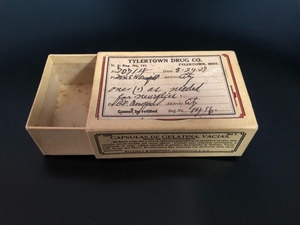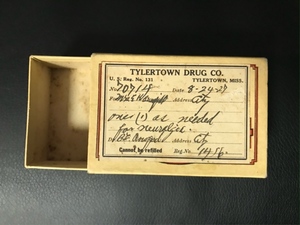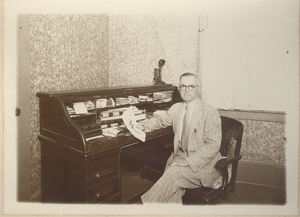TYLERTOWN DRUG COMPANY MEDICINE OR PILL CONTAINER, 1927— These images are of a rare relic of medicine from the early 20th century: a small cardboard prescription drug container, approximately three inches by two inches by one inch, dated August 24, 1927 from Tylertown, Mississippi. The top of the box contains regulatory information on the prescription, seemingly surprising for such a time, and its side contains an advertisement for “Capsulas De Gelatina, Vacias” (empty gelatin capsules) written in Spanish yet produced by Eli Lilly & Company, suggesting Tylertown Drug Company, the source of the prescription, was either given the box by Eli Lilly or purchased it, perhaps at a reduced rate from a supply of boxes intended for a pharmacy in a Spanish speaking country. The top information was written on a form pasted to the medical box. The medical container apparently is for an opiate or other controlled substance. The physician is listed as Dr. B. L. Crawford of Tylertown, and his Registration Number is noted as 1416, similar to our current DEA registration. The drugstore is also registered to dispense this medicine, and the prescription number is even listed. The patient, Mrs. Brumfield, is also listed. The directions are written to take “one (1) as needed for neuralgia,” which implies a painful neuropathic condition such as trigeminal neuralgia.
This old cardboard paper box reveals much about the early efforts to regulate physician and pharmacy prescribing of narcotics. At the turn of the 20th century, no federal regulations existed to protect the public from addictive or dangerous drugs. In an era of useless so-called “snake oil” and worthless pseudo-medical remedies promoted as cures for various illnesses, opium (and other) addictions became epidemic in the general population, peaking in 1896. The original Pure Food and Drugs Act was passed by Congress in 1906 and signed by President Theodore Roosevelt. The law prohibited misbranded and altered food, drinks, and drugs in interstate commerce, and required the labeling of patent medicines that contained opiates, cocaine, alcohol, and other intoxicants. Despite progress with the abuse of opiates, further action was needed. In 1914, The Harrison Narcotic Tax Act was enacted which required prescriptions for products exceeding the allowable limit of narcotics and mandated increased record-keeping for physicians and pharmacists who dispense narcotics. It required registration for anyone dealing in opiates, including physicians and pharmacies. The intent of the act was to bring narcotics under better control, limiting the distribution to legitimate medical channels. This 1927 pill container displays these required registrations for both the pharmacy and the physician.1
Pills and tablets have been used by physicians and patients for more than a millennia, with evidence of them dating to ancient times, offering desired doses and easy administration for therapeutic treatment. (Even before pills, herbs and other oral therapies were simply added to liquids for drinking.) The first pills were made by incorporating the medicinal agent with something sticky that was edible, such as honey or dough, with Greeks and Romans recording such use. Gelatin pills were invented in the 1830s, which marks the beginning of modern pill production. The medicinal ingredients would be stuck with a pin, then inserted into hot gelatin and left to dry. Sugar pills used gum as a base, and tablets evolved from machine-pressed powder ingredients. Pharmacies over centuries have used everything from stoneware to glass bottles to tin containers to cardboard to plastic bottles and packaging to contain medicine as pills, powders, and liquids. Early twentieth century use of cardboard as pill containers was common; however, survival of such containers is relatively rare due to their fragility.
The physician who wrote this prescription was a respected and well-known pioneer physician in South Mississippi: Dr. Benjamin Lampton Crawford, Sr. (1879-1964). This Walthall County native graduated from Mississippi College and followed his physician brother Walter to Tulane and Jefferson Medical College, where he graduated with his MD in 1904. He then performed his “interne” work briefly in Fernwood before working for several years with his brother at the South Mississippi Infirmary in Hattiesburg. However, his father and sisters coaxed him eventually back to his native Tylertown, where “Lampton” (which was the name he went by) opened an office above the Tylertown Drug Store in 1908. Although he admitted patients and managed for a period Tylertown Hospital in 1929-30, he eventually created in 1938 16-bed Walthall Hospital on Tylertown’s Beulah Avenue with his eldest son Dr. Everett Crawford, and in 1939, added a ten-room annex which included a charity ward in the basement floor and a nurses home behind the structure. With the addition of Drs. Walter and Ben Crawford in the post-war period, the hospital would grow further, eventually expanding to 80 rooms.2–4
Lampton Crawford was MSMA president from 1944-46, serving longer in that position than any other person in the history of the MSMA. He was the only president to serve a two-year term, a result of U.S. involvement in the Second World War and the decision of the board not to hold an annual session in 1945. He also served on the State Board of Health from 1916-1924 and was a charter member of the Tri-County (now South Central) Medical Society. He was credited in his obituary with having delivered over 6,000 babies during his medical career and was described as “a country doctor in the best tradition.” He also was a key leader in the drive to create Walthall County in 1914 from Pike and Marion Counties. His three sons, Everett, Walter, and Ben, all veterans of the Second World War, would serve by his side as physicians in Tylertown for decades. He died in the hospital he founded in 1964, after sixty years of practice.3–6
The photograph of Dr. Crawford is from the late 1920s and is taken in his Tylertown office which was located above the Tylertown Drug Store on Beulah Avenue. He is sitting at his roll top desk with a candlestick phone atop, holding a piece of paper featuring the two-barred cross, which was the logo of the International Union Against Tuberculosis and The American Lung Association. This modified version of the Cross of Lorraine was originally suggested as a symbol for the “crusade” against tuberculosis in 1902 by French physician Gilbert Sersiron. Dr. Crawford was leading his community’s crusade against the dreaded disease, which was caused by Mycobacterium tuberculosis bacteria, called at the time “The White Plague” and consumption.7
For more on the Crawford family in Mississippi medicine, see the March/April 2024 Journal.8 If you have an old or even somewhat recent photograph which would be of interest to Mississippi physicians, please send it to me at drluciuslampton@gmail.com or by snail mail to the Journal. — Lucius M. “Luke” Lampton, MD; JMSMA Editor






